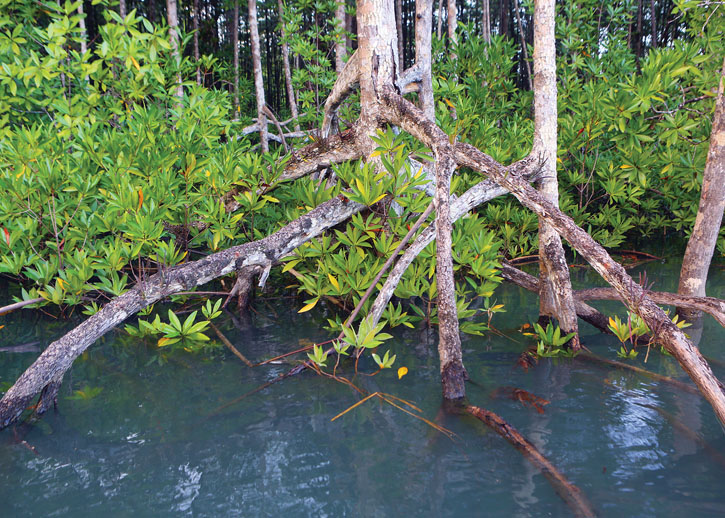Costa Rica’s shorelines are home to five species of mangroves. These pioneer land builders thrive at the interface of land and sea, forming a stabilizing tangle that fights tidal erosion and reclaims land from the water.
Mangroves build up the soil until they strand themselves high and dry. In the end they die on the land they have created.Mangroves are what botanists call halophytes, plants that thrive in salty conditions. Costa Rica’s rivers deposit silt and volcanic ash onto the coastal alluvial plains. The nutrient-rich mud generates algae and other small organisms that form the base of the marine food chain. Their sustained health is vital to the health of other marine ecosystems.The nutrients the mangroves seek lie near the surface of the acid mud, deposited by the tides. There is no oxygen to be had in the mud, hence there is no point in the mangroves sending down deep roots. Instead, they send out aerial roots, maintaining a hold on the glutinous mud and giving the mangroves the appearance of walking on water. They draw oxygen from the air through small patches of spongy tissue on their bark.

Mangroves thrive in brackish water; they fight tidal erosion and act as nurseries for a variety of marinelife. Photo © Christopher P. Baker.
The irrepressible, reddish-barked, shrubby mangroves rise from the dark water on interlocking stilt roots. Brackish streams and labyrinthine creeks wind among them like snakes, sometimes interconnecting, sometimes petering out in narrow cul-de-sacs, sometimes opening suddenly into broad lagoons.
Mangrove swamps are esteemed as nurseries of marinelife and as havens for waterbirds—cormorants, frigate birds, pelicans, herons, and egrets—that feed and nest here by the thousands, producing guano that makes the mangroves grow faster.
A look down into the water reveals luxuriant life: oysters and sponges attached to the roots, small stingrays flapping slowly over the bottom, and tiny fish in schools of tens of thousands. Baby black-tipped sharks and other juvenile fish also spend much of their early lives among mangrove roots, shielded by the root maze that keeps out large predators. Raccoons, snakes, and arboreal creatures also inhabit the mangroves. There is even an arboreal mangrove tree crab (Aratus pisonii), which eats mangrove leaves and is restricted to the very crowns of the trees by the predatory activities of another arboreal crab, Goniopsis pulchra.
Mangroves are aggressive colonizers, thanks to one of nature’s most remarkable seedlings. The heavy, fleshy mangrove seeds, shaped like plumb bobs, germinate while still on the tree. The flowers bloom for a few weeks in the spring and then fall off, making way for a fruit. A seedling shoot soon sprouts from each fruit and grows to a length of 15 to 30 centimeters (6-12 inches) before dropping from the tree. Falling like darts, at low tide they land in the mud and put down roots immediately. Otherwise, a seaborne seedling may drift for hundreds of miles. Eventually, it touches the muddy floor and anchors. By its third year a young tree starts to sprout its own forest of arching prop roots; in about 10 years it has fostered a thriving colony of mangroves, which edge ever out to sea, forming a great swampy forest. As silt builds up among the roots, land is gradually reclaimed from the sea. Mangroves build up the soil until they strand themselves high and dry. In the end they die on the land they have created.
Excerpted from the Tenth Edition of Moon Costa Rica.